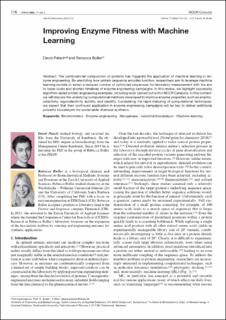Please use this identifier to cite or link to this item:
https://doi.org/10.21256/zhaw-29459| Publication type: | Article in scientific journal |
| Type of review: | Peer review (publication) |
| Title: | Improving enzyme fitness with machine learning |
| Authors: | Patsch, David Buller, Rebecca |
| et. al: | No |
| DOI: | 10.2533/chimia.2023.116 10.21256/zhaw-29459 |
| Published in: | Chimia |
| Volume(Issue): | 77 |
| Issue: | 3 |
| Page(s): | 116 |
| Pages to: | 121 |
| Issue Date: | 29-Mar-2023 |
| Publisher / Ed. Institution: | Swiss Chemical Society |
| ISSN: | 0009-4293 2673-2424 |
| Language: | English |
| Subjects: | Bioinformatics; Enzyme engineering; Halogenase; Industrial biocatalysis; Machine learning; Catalysis; Data collection; Machine learning; Algorithm; Engineering |
| Subject (DDC): | 006: Special computer methods 660.6: Biotechnology |
| Abstract: | The combinatorial composition of proteins has triggered the application of machine learning in enzyme engineering. By predicting how protein sequence encodes function, researchers aim to leverage machine learning models to select a reduced number of optimized sequences for laboratory measurement with the aim to lower costs and shorten timelines of enzyme engineering campaigns. In this review, we will highlight successful algorithm-aided protein engineering examples, including work carried out within the NCCR Catalysis. In this context, we will discuss the underlying computational methods developed to improve enzyme properties such as enantioselectivity, regioselectivity, activity, and stability. Considering the rapid maturing of computational techniques, we expect that their continued application in enzyme engineering campaigns will be key to deliver additional powerful biocatalysts for sustainable chemical synthesis. |
| URI: | https://digitalcollection.zhaw.ch/handle/11475/29459 |
| Fulltext version: | Published version |
| License (according to publishing contract): | CC BY 4.0: Attribution 4.0 International |
| Departement: | Life Sciences and Facility Management |
| Organisational Unit: | Institute of Chemistry and Biotechnology (ICBT) |
| Appears in collections: | Publikationen Life Sciences und Facility Management |
Files in This Item:
| File | Description | Size | Format | |
|---|---|---|---|---|
| 2023_Patsch-Buller_Improving-enzyme-fitness-with-ML.pdf | 536.31 kB | Adobe PDF |  View/Open |
Show full item record
Patsch, D., & Buller, R. (2023). Improving enzyme fitness with machine learning. Chimia, 77(3), 116–121. https://doi.org/10.2533/chimia.2023.116
Patsch, D. and Buller, R. (2023) ‘Improving enzyme fitness with machine learning’, Chimia, 77(3), pp. 116–121. Available at: https://doi.org/10.2533/chimia.2023.116.
D. Patsch and R. Buller, “Improving enzyme fitness with machine learning,” Chimia, vol. 77, no. 3, pp. 116–121, Mar. 2023, doi: 10.2533/chimia.2023.116.
PATSCH, David und Rebecca BULLER, 2023. Improving enzyme fitness with machine learning. Chimia. 29 März 2023. Bd. 77, Nr. 3, S. 116–121. DOI 10.2533/chimia.2023.116
Patsch, David, and Rebecca Buller. 2023. “Improving Enzyme Fitness with Machine Learning.” Chimia 77 (3): 116–21. https://doi.org/10.2533/chimia.2023.116.
Patsch, David, and Rebecca Buller. “Improving Enzyme Fitness with Machine Learning.” Chimia, vol. 77, no. 3, Mar. 2023, pp. 116–21, https://doi.org/10.2533/chimia.2023.116.
Items in DSpace are protected by copyright, with all rights reserved, unless otherwise indicated.